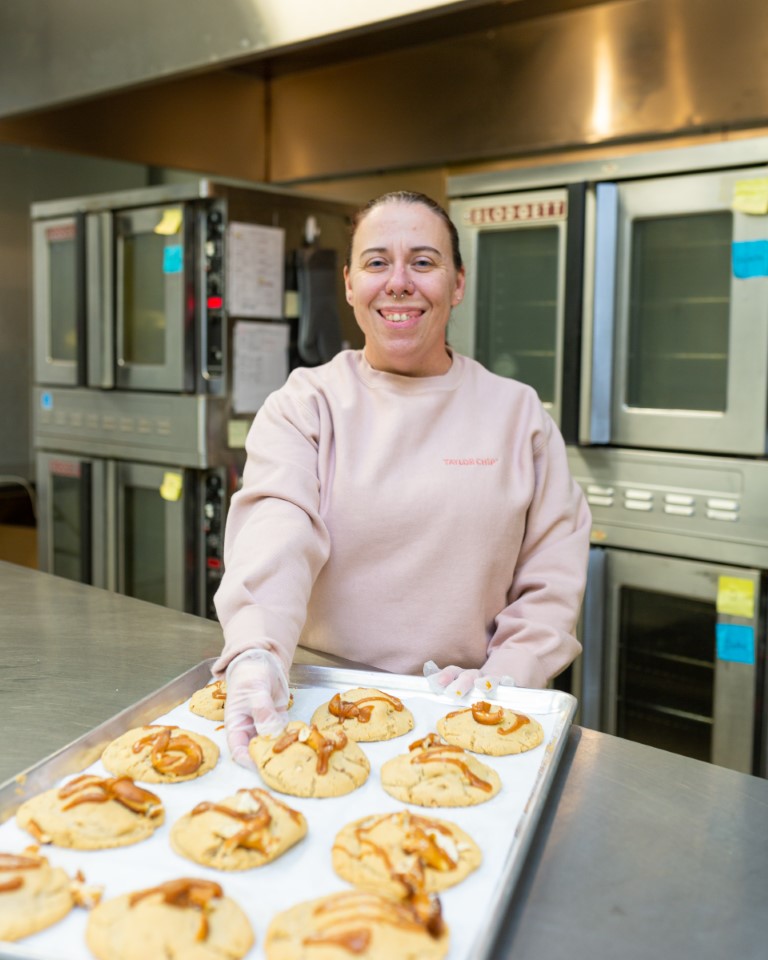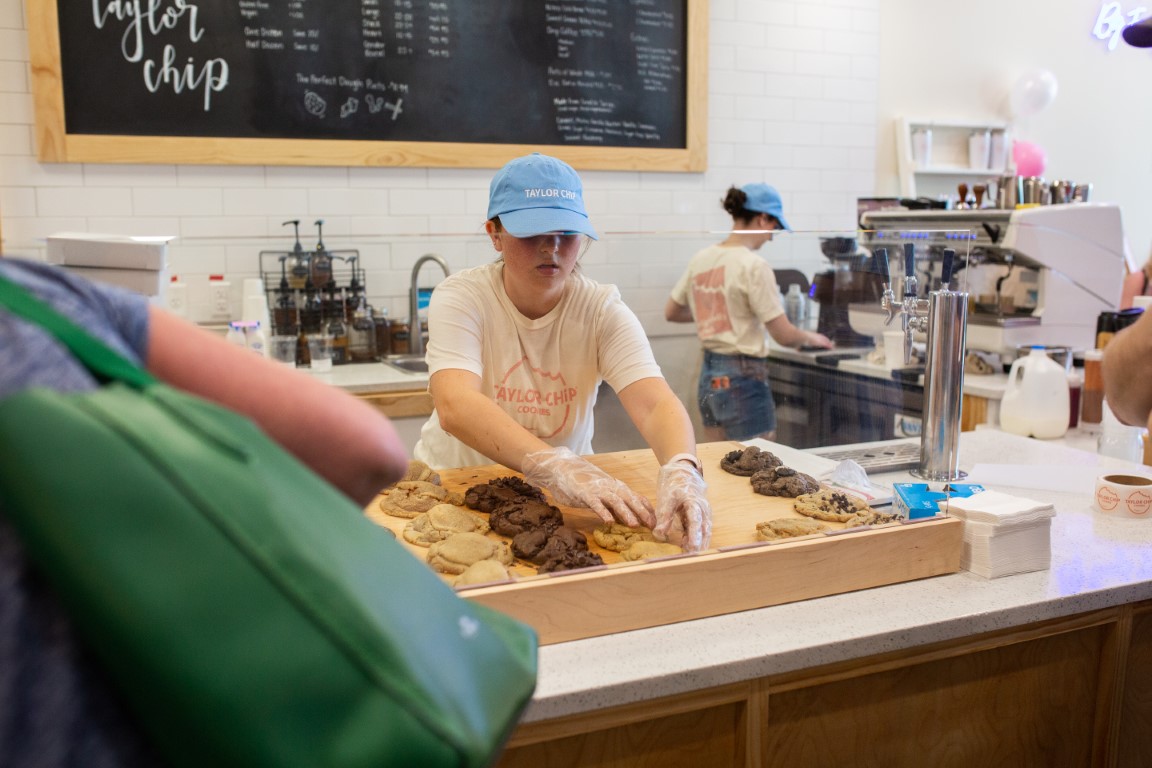You'll find that brown sugar is commonly used in cookie recipes for its unique contribution to both flavor and texture. With its molasses content, brown sugar lends a richer, caramel-like taste and adds moisture, leading to a chewy texture that white sugar alone can't provide. This guarantees chewy cookies with soft centers and crisp edges, enhancing overall satisfaction. While possible, substituting brown sugar with alternatives like white sugar and molasses, or maple syrup, can alter cookie characteristics, often resulting in a lighter color and different texture. To explore more about substitutions and their impacts, consider examining detailed recipes.
Key Takeaways
- Brown sugar adds moisture and a chewy texture to cookies, enhancing their overall quality.
- It provides a rich caramel flavor, enhancing the depth and enjoyment of baked goods.
- Using brown sugar is essential for achieving soft centers and crispy edges in cookies.
- Substitutes like white sugar affect flavor depth, resulting in different cookie characteristics.
- Brown sugar's molasses content impacts the color and sweetness level of cookies.
Understanding Brown Sugar Basics
You might wonder what sets brown sugar apart from white sugar, and the answer lies in its molasses content, which gives it a distinct flavor and moisture level. Brown sugar is made by either adding molasses to refined white sugar or by leaving some of the natural molasses intact during the sugar production process. This difference in processing not only affects the taste and texture of your cookies but also how they spread and brown during baking.
What Makes Brown Sugar Different From White Sugar
Unlike white sugar, brown sugar contains molasses, giving it a distinct flavor and moisture content that can greatly affect your baked goods. This bit of molasses mixed into brown sugar results in a rich caramel flavor, adding depth of flavor to your cookies. The presence of molasses also contributes to a soft texture, making your homemade cookies delightfully chewy. When you choose sugar in cookies, the type matters; brown sugar, with molasses added, provides a more intricate taste compared to the straightforward sweetness of white sugar. This intricacy is especially noticeable in cookies where the sugar type influences both the texture and the taste, ensuring a unique and enjoyable eating experience. Understanding these differences can enhance your cookie-baking adventures.
How Brown Sugar Is Made and Processed
While it may seem simple, the process of making brown sugar involves a careful balance of sugar and molasses. Typically, a tablespoon of molasses is mixed with white sugar, creating the rich brown sugar you use in recipes. This combination enhances sugar chocolate chip cookies, providing a chewier texture and a delightful caramel undertone. The type of molasses, like blackstrap molasses, influences the flavor and color, with some opting for dark corn syrup or even maple syrup for variation.
The result is a complex flavor profile, adding depth to your brown sugar chocolate chip cookies. The interaction of molasses creates a nutty flavor, making the sugar more than just sweet. Understanding this process allows you to appreciate the distinct characteristics brown sugar brings to baking.

Choose Your Own Delightfully Perfect Cookies.
With almost 30 flavors to choose from, you can make your box as unique as you are.
The Impact of Brown Sugar in Cookie Baking
When you use brown sugar in cookie baking, it greatly influences both the flavor and texture, offering a deeper sweetness and a moist, chewy bite. The molasses in brown sugar is responsible for this effect, which is why some cookie recipes specifically call for it to achieve that distinctive rich taste and soft consistency. Understanding these attributes can help you make informed choices about when to substitute brown sugar or stick to the original recipe to get your desired results.
How Brown Sugar Affects Cookie Flavor and Texture
Brown sugar plays an essential role in determining the flavor and texture of your cookies. When you add it to your chocolate chip cookie recipe, it introduces a rich, caramel-like taste that granulated sugar alone can't provide. The moisture in brown sugar, combined with the unsalted butter, helps create chewy chocolate chip cookies. When mixed with your dry ingredients, it contributes to a balanced cookie dough, ensuring soft chocolate chip cookies with just the right amount of give. Additionally, brown sugar aids in achieving those desirable crisp edges when baked on a baking sheet. Its molasses content adds depth of flavor and moisture, enhancing the overall texture and making each bite more satisfying. Brown sugar's presence is essential for delicious cookies.
Why Some Cookie Recipes Specifically Call for Brown Sugar
Not all cookie recipes are created equal, and some specifically call for brown sugar to achieve that perfect balance of flavor and texture. In a classic chocolate chip cookie, brown sugar plays a vital role among the wet ingredients. It adds moisture, which contributes to chewier cookies with a soft centre. The molasses in brown sugar also enhances the depth of flavor, making your delicious cookies stand out. When you combine the brown sugar with the butter mixture, it helps create those desirable crispy edges. The interaction between the brown sugar and the flour mixture is critical for achieving the right consistency in many cookie recipes. Ultimately, brown sugar can transform the texture and taste of your cookies, making them truly irresistible.
Alternatives to Brown Sugar in Cookies
You might wonder what to use if you're out of brown sugar, but don't worry, there are several effective substitutes like white sugar mixed with molasses, honey, or maple syrup that can maintain your cookie's flavor and texture. Each alternative will slightly alter the taste and moisture content of your cookies, so it's important to understand how these changes might affect your final product. By experimenting with these substitutions, you can still achieve delicious results while accommodating your pantry's limitations.
Best Substitutes for Brown Sugar
When you're out of brown sugar and still craving those perfectly chewy cookies, don't worry—there are plenty of substitutes that can step in without compromising flavor or texture. Here are some options:
- White Sugar and Molasses: Mix one cup of white sugar with one tablespoon of molasses. This combination mimics the richness of brown sugar, perfect for your chocolate chip cookies recipe.
- Maple Syrup: Substitute with equal parts maple syrup, adjusting baking soda and vanilla extract for balance. The syrup adds a subtle depth to homemade chocolate chip cookies.
- Honey: Use honey in place of brown sugar, but reduce melted butter slightly to avoid excess moisture.
- Coconut Sugar: This natural alternative brings a unique flavor to cookies, and pairs well with dark chocolate and egg substitutes on parchment paper.
How Substitutions Affect Cookie Results
Often, experimenting with alternatives to brown sugar in cookies can lead to surprising results, both in flavor and texture. Using white sugar in place of brown sugar when making classic chocolate chip cookies impacts both their appearance and consistency. Brown sugar contributes to a thicker cookie that's golden brown and chewier, while white sugar will result in a lighter color and a crisper texture. In a medium bowl, combine your ingredients, blending them with an electric mixer. When forming the dough into balls, you'll notice a difference in pliability. Adding semisweet chocolate chips will provide richness, but the overall cookie might lack the depth of flavor brown sugar offers. Each substitution alters the final product, so choose based on your desired cookie characteristics.
Essential Brown Sugar Baking Tips
When baking cookies, proper measuring and storage of brown sugar are essential to achieving the perfect texture and flavor, so make certain you pack it firmly into the measuring cup to guarantee accuracy. Store your brown sugar in an airtight container to prevent it from drying out, and if it becomes hard, a slice of bread or a damp paper towel can help restore its moisture. If you encounter issues like clumping or hardening, these simple troubleshooting tips will keep your brown sugar ready for all your baking needs.
Proper Measuring and Storage Methods
As you engage yourself in baking, mastering the proper measuring and storage methods for brown sugar is key to achieving perfect cookies. Start by accurately measuring the brown sugar to guarantee your recipe card is followed precisely. Here's a quick guide:
- List of Ingredients: Gather all items, including brown sugar, before starting.
- Mixing Bowl: Use it to cream butter and brown sugar together until smooth.
- Step Instructions: Add teaspoons vanilla extract and mix at medium speed for consistency.
- Cookie Dough Ball: Form evenly sized balls to guarantee uniform baking.
To store brown sugar properly, seal it in an airtight container to maintain moisture. This guarantees your baked cookies, once cooled on a wire rack, have the perfect texture.
Troubleshooting Common Brown Sugar Issues
Mastering the storage and measuring of brown sugar is only part of the journey to perfect cookies. Sometimes, unbaked cookie dough can spread too much or not enough. First, check your purpose flour and verify it's accurately measured. In a separate bowl, combine a teaspoon baking soda and teaspoon salt to avoid clumping. If your dough is too sticky, try chilling it before shaping. Use a medium cookie scoop to form uniform dough balls, placing tablespoons of dough on prepared baking sheets. Bake them in a preheated oven to maintain consistent temperatures. If your cookies don't rise, the dough might be too old or improperly mixed. Adjust these elements to prevent common issues and achieve deliciously consistent cookies.
Our Journey from Cookie Enthusiasts to Baking Experts
At Taylor Chip, our expertise in cookie baking isn't just professional—it's deeply personal. Since 2015, we've dedicated ourselves to mastering the art and science of cookie baking, with a particular focus on understanding the intricate role of ingredients like brown sugar in creating the perfect cookie. Through years of hands-on experimentation and countless batches of cookies, we've developed an intimate understanding of how different sugars affect texture, moisture content, and flavor profiles. Our journey began as a shared passion project, testing and refining recipes until we achieved what we consider the perfect cookie formula. This wasn't just about following recipes—it involved extensive experimentation with various ingredients, ratios, and techniques.
We've personally tested every substitution and alternative mentioned in this article, observing how different sugars and sweeteners affect the final product. This hands-on experience has given us unique insights into the chemistry of cookie baking, particularly regarding the crucial role of brown sugar in achieving that ideal balance of chewiness and flavor. What sets our expertise apart is our commitment to perfection through practical experience.
We've spent years fine-tuning our understanding of how ingredients interact, testing countless variations until we achieved consistently outstanding results. This article draws from our real-world experience of baking thousands of cookies and perfecting our techniques, allowing us to share not just theoretical knowledge, but practical insights gained from extensive hands-on experience in both home and commercial baking environments.
Frequently Asked Questions
How Does Brown Sugar Affect Cookie Shelf Life?
Brown sugar adds moisture to your cookies, helping them stay soft and fresh longer. Its molasses content acts as a natural preservative. Without it, your cookies might dry out and become stale more quickly.
Can Brown Sugar Be Used in No-Bake Cookie Recipes?
You can definitely use brown sugar in no-bake cookie recipes. It adds a rich, molasses flavor and helps bind ingredients together. Just confirm it's well-mixed for smoothness and a perfect texture in your no-bake treats.
What Are the Health Implications of Using Brown Sugar in Cookies?
Using brown sugar in cookies can impact your health by adding calories and affecting blood sugar levels. It's less refined than white sugar, so it retains some minerals, but moderation is essential for a balanced diet.
Is There a Difference in Taste Between Light and Dark Brown Sugar in Cookies?
You'll notice a taste difference between light and dark brown sugar in cookies. Light brown sugar adds a mild, sweet molasses flavor, while dark brown sugar offers a richer, more intense taste that enhances cookie depth.
How Does Brown Sugar Influence the Color of Baked Cookies?
Brown sugar darkens cookies, giving them a richer color due to its molasses content. You'll notice a deeper, caramel hue compared to cookies made with white sugar. The more brown sugar you use, the darker they'll become.
Conclusion
To sum up, you don't need brown sugar to bake cookies, but it greatly influences their flavor and texture, adding moisture and a richer taste. If you're out of brown sugar, alternatives like white sugar mixed with molasses or honey can work, though results may vary. Understanding brown sugar's role in baking helps you choose the right substitutes and achieve your desired cookie outcome. Remember, experimenting with different ingredients can lead to delightful, unique cookie creations.










